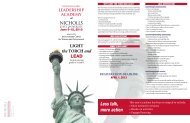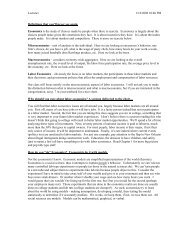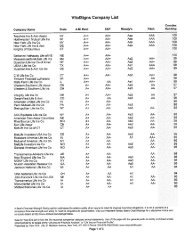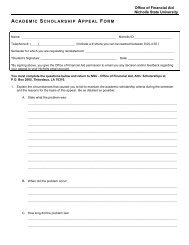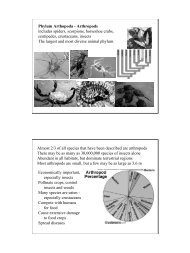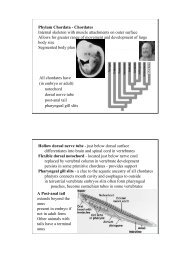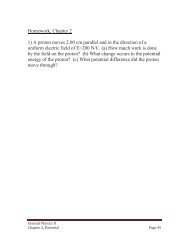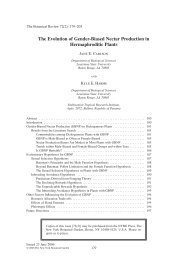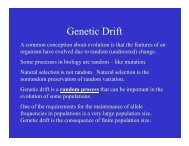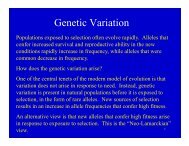Voila 2007 Fall (PDF) - Nicholls State University
Voila 2007 Fall (PDF) - Nicholls State University
Voila 2007 Fall (PDF) - Nicholls State University
Create successful ePaper yourself
Turn your PDF publications into a flip-book with our unique Google optimized e-Paper software.
in the attic of the old Lafourche jail. Most<br />
were in French and English, some in Spanish.<br />
The collection includes an 1855 report<br />
on conditions in the Lafourche jail (“filthy<br />
and nauseating”), an 1855 dental bill and<br />
cattle-brand certificates.<br />
But most of those records are writs,<br />
deeds and lawsuits, to say nothing of birth,<br />
death and marriage certificates. Some are<br />
original documents, some copies. “Can<br />
you imagine copying documents by hand<br />
way back then,” Legendre says in astonishment.<br />
“Marge did the database for all<br />
25,000 records,” she says. As a result, references<br />
to plantations, people, businesses<br />
and similar topics can be easily found.<br />
Plantations start with Abby and end with<br />
Waverly.<br />
“I love it,” Legendre says of her volunteer<br />
work. “You find out so many interesting<br />
things.” She considers slave records<br />
particularly interesting, “especially those<br />
in the 1700s that list slaves coming from<br />
Africa by way of Haiti.”<br />
Speaking of her work on old Lafourche<br />
records, Landry says, “That was<br />
fun because most of my people are from<br />
Lafourche – Guillots, Thibodauxs and<br />
what-have-you. I was so interested that<br />
sometimes I would come in for an extra<br />
day.” While organizing a collection of<br />
sheet music dating as far back as 1868, she<br />
tells of having found bullets among the<br />
Goldie Legendre (left) and Marjorie Landry (right) have worked as volunteers in the<br />
library archives two days a week for more than a decade.<br />
criminal records and information about a<br />
nose being bitten off in one case, an ear in<br />
another.<br />
Seeing, touching history<br />
Theriot can tell of dozens of fascinating<br />
items in the collection. He can produce<br />
documents signed by Henry Schuyler<br />
Thibodaux, Francis T. <strong>Nicholls</strong> and James<br />
Bowie. He can display 1796 slave-sale<br />
information on the back of a 1787 baptismal<br />
certificate. He can pull out hundreds<br />
of printed public death notices, which<br />
genealogists often find invaluable. He can<br />
scan and e-mail documents or burn them<br />
onto compact discs when requests come<br />
from far away.<br />
Theriot delights in introducing freshmen<br />
to the archives when their classes<br />
tour the library. He lets them see and hold<br />
letters signed by Presidents Roosevelt,<br />
Eisenhower and Johnson. They even see<br />
and hold Ellender’s invitation to John F.<br />
Kennedy’s presidential inauguration.<br />
From the Martin-Pugh papers, which<br />
extend from the 1830s to the 1920s, Theriot<br />
is able to show letters from four sons<br />
telling of their Civil War battlefield experiences.<br />
There are also letters from their relatives<br />
on the bayou describing home-front<br />
conditions. Many envelopes have five-cent<br />
“Confederate <strong>State</strong>s” stamps. Because the<br />
letters have been transcribed, no researcher<br />
need wear gloves or be slowed by quaint<br />
penmanship.<br />
Theriot enjoys showing visitors Civil<br />
War letters penned in the normal fashion<br />
and then turned 180 degrees for additional<br />
writing across the previously written lines,<br />
all because of the paper shortage. He even<br />
has letters on which the penmanship crosses<br />
horizontally, vertically and diagonally.<br />
Holding up a newspaper printed on<br />
the back of green wallpaper, Theriot says,<br />
“Students love this.” It is La Sentinelle de<br />
Thibodaux issued in French on Feb. 7,<br />
1863. Students are unlikely to forget the<br />
Civil War paper shortage.<br />
Theriot also shows students The Banner<br />
of the Ironsides, a newspaper printed in<br />
Thibodaux by Union forces on April 14,<br />
1863. “We have two issues, the only two<br />
in Louisiana,” he says, “although there are<br />
one or two somewhere up North.” Students<br />
are surprised to see the first <strong>Nicholls</strong><br />
catalog and its listing of the 1948 registration<br />
fee of only $17.50.<br />
When people give items to the<br />
archives, they are asked to sign a formal<br />
agreement before <strong>Nicholls</strong> accepts what<br />
has historical value and declines inappropriate<br />
items, such as museum objects. In<br />
rare instances, exceptions will be made, as<br />
in the case of Evangeline Baseball League<br />
items like uniforms and mitts that accompanied<br />
league photographs and records<br />
dating from 1934 to 1957. Archives also<br />
has a Civil War canon ball.<br />
An ever-growing collection<br />
Growth has created an “Archives II,” a<br />
huge room on the other side of the building<br />
housing mostly unprocessed items. An<br />
assistant archivist was added to the staff<br />
during the summer, primarily to process<br />
collections according to professional<br />
standards. The papers of former President<br />
Donald Ayo await processing.<br />
“Archives II” also contains the J.A.<br />
and J.C. Lovell collection of historic field<br />
notes, maps, abstracts and aerial photographs,<br />
a boon to professional surveyors<br />
interested primarily in Lafourche and<br />
Terrebonne tracts. The collection, bought<br />
by Louisiana Land & Exploration in 1962<br />
and given to <strong>Nicholls</strong> in 1995, is stored in<br />
enormous but shallow pull-out trays.<br />
Some <strong>Nicholls</strong> collections have been<br />
duplicated and shared with area libraries,<br />
such as the genealogical papers of<br />
Olga Laurent, a schoolteacher from the<br />
river parishes, who gathered information<br />
about many families along the River Road.<br />
Original 1801 Engraving of Shakespeare’s “King Richard II”<br />
Mathias also cites the popular collection of<br />
Doris Mae Ledet of Thibodaux, “a premier<br />
genealogist in this area, who allowed us to<br />
make copies of much of her material.”<br />
<strong>Nicholls</strong> archives began in 1964 when<br />
the library moved from a few rooms in Elkins<br />
Hall to Polk Hall. It expanded when<br />
the Ellender building opened in 1980. In<br />
addition to processing and maintaining<br />
the collection, the staff stays busy responding<br />
to requests, such as those of people<br />
who planned the <strong>2007</strong> observance of<br />
Lafourche Parish’s bicentennial.<br />
Quirky Archives Finds<br />
From an 1881 Lafourche Parish case involving stolen peas:<br />
the charge sheet, the affidavit, the warrant, the subpoena,<br />
the guilty judgment – and 22 peas in an evidence envelope.<br />
18 | Voilà! 19 | Voilà!



